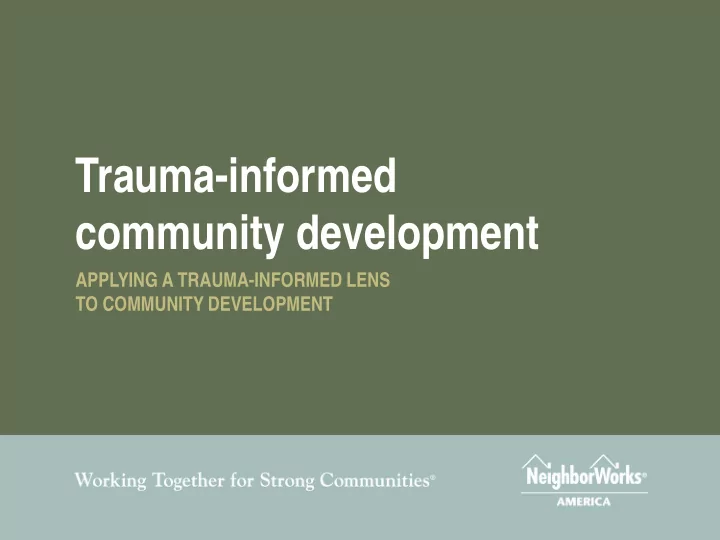

Trauma-informed community development APPLYING A TRAUMA-INFORMED LENS TO COMMUNITY DEVELOPMENT
Healthy homes & communities Building communities of opportunity that support resident health and well-being Sarah Norman, Director Healthy Homes & Communities NeighborWorks America
NeighborWorks Healthy Communities Demonstration Project Thanks for the generous support from the County Health Ranking & Roadmaps Program and the Robert Wood Johnson Foundation
Emerging themes
Zoë Van Orsdol Impact and Tess Donie New Kensington Community Development Corporation
TRAUMA HOW OW INFORMED COMMUNITY WHAT AT DEVELOPMENT
What is T r auma? “ Trauma is to mental health “T ra uma -info rme d c a re is as smoking is to cancer.” a n a ppro a c h to e ng a g ing pe o ple with - Dr. Steven Sharfstein histo rie s o f tra uma tha t re c o g nize s the pre se nc e “Childhood trauma, in public o f tra uma sympto ms a nd a c kno wle dg e s the health, is probably considered ro le tha t tra uma ha s today the single greatest pla ye d in the ir live s.” preventable cause of mental illness.” ( http:/ / www.sa mhsa .g o v/ n ctic) - Dr. Ken Spiegelman
F r e que nc y of T r auma 1/ 3 o f c hildre n will witne ss do me stic vio le nc e . We ll o ve r 80% o f Ame ric a ns ha ve e xpe rie nc e d tra uma , inc luding witne ssing o r b e ing ta rg e t o f thre a ts o f vio le nc e a nd sudde n lo ss o f a lo ve d o ne . Only a sma ll pe rc e nta g e a re dia g no se d with a tra uma re la te d stre ss diso rde r.
E ffe c ts of T r auma Adult inc o me is c lo se ly c o rre la te d with ACE sc o re s – tho se who ma ke le ss tha n $25,000 pe r ye a r a re a lmo st twic e a s like ly to ha ve e xpe rie nc e d fo ur o r mo re ACE s a s tho se who ma ke mo re (O’ Co nne r, F inkb ine r, & Wa tso n, 2012) Alte rs the b ra in: e xe c utive func tio n, a tte ntio n, me mo ry se q ue nc ing , pla nning , a nd visua l-spa tia l func tio n (Da ne se , De Be llis, T e ic he r, 2015) Ca nc e r, COPD, o b e sity, dia b e te s, he a rt dise a se , c hro nic pa in, live r dise a se , hig h b lo o d pre ssure
T r auma- Infor me d Car e Conc e pts A ba sic Sa fe ty both unde rsta nding of e motiona lly a nd tra uma e nvironme nta lly A stre ng th- ba se d a pproa c h to se rvic e s
F r om: “What’s wr ong with you?” “What happe ne d to you?” T o: Re sto re Po we r Suppo rt Se lf-Wo rth Cho ic e Re spe c t E mpo we rme nt L iste ning Stre ng ths Co lla b o ra tio n pe rspe c tive Co mpa ssio n Skill b uilding Mutua lity Mo de ling Re la tio nship
ks N’Camde n Hope wor E valuator s: Dr . Natasha F le tc he r & Asia King Ado pte d Sa nc tua ry Mo de l 2013-2015 Sinc e b e c o ming tra uma info rme d: Pro g ra m c o mple tio n ra te inc re a se d b y 20% E nro llme nt is rising Sta ff re po rt “re ma rka b le ” jo b sa tisfa c tio n E na b le suc c e ss fo r “a wide r spe c trum o f yo ung pe o ple ” Co lla b o ra tive a tmo sphe re with “mutua l re spe c t a nd trust” I nte rnships ha ve se t hig he r sta nda rds a nd pa rtic ipa nts ha ve rise n to the c ha lle ng e
TRAUMA-INFORMED COMMUNITY ENGAGEMENT Building healthy resident-led micro-communities
Ke nsington, Philade lphia Demographics Challenges 21,390 people High rates of crime, • • 60% Hispanic, 29% drugs, prostitution • African American, Lack of social • 29% White cohesion 35% under age 18 Significant homeless • • <35% of adults finish population • High School Lack of quality • 60% of households education at all • earn under levels $25,000/year High vacancy rates • 47% of households Lack of private • • led by single adults investment with children
How did we ge t he r e ?
Trauma-informed community building: A model for strengthening communities in trauma-affected neighborhoods Principals: Systems 1. Do No Harm 2. Acceptance 3. Community Community empowerment 4. Reflective process Interpersonal Individua l Weinstein, Wolin, and Sherin Rose, “Trauma-informed community building”, BRIDGE Housing and Health Equity Institute, May 2014.
Co nne c ting he alth and c o mmunity Acknowledgments de ve lo pme nt Thanks to the Robert Wood Johnson Foundation and the County Health Rankings & Roadmaps Program for generous support Thanks to Susan Jouard (NeighborWorks America) for conceptualizing this workshop Photograph: TNDC Pho to s: T NDC
Recommend
More recommend